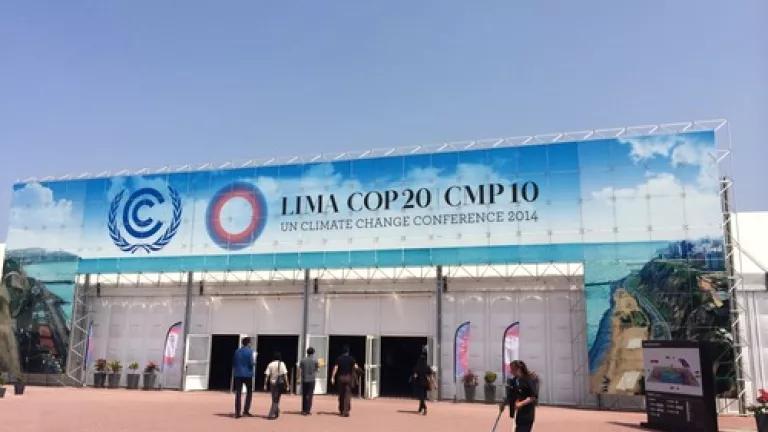
Negotiators have spent the last week in Lima, Peru trying to lay the foundation for a strong agreement next year in Paris. Unfortunately we have gone through the normal routine of foot dragging and posturing from some countries. As Ministers arrive they have the chance to rise above the dynamics of their negotiators and show that they are prepared to help create a strong legacy on climate change.
As we came into Lima, I outlined several key steps that Lima needs to deliver to help set the world in the right direction for a strong agreement next year. Ministers have their work cut out for them next week as these issues haven’t been resolved by their negotiators. Here is where things stand.
Entrance to the Lima COP building as Ministers arrive (NRDC)
Agree that countries will propose targets for 2025 instead of 2030. One of the key issues for next year is the timeframe for the next round of targets. Many countries prefer that countries commit to 2025 targets to help show that they are serious. After all, we don’t have time to delay action. We need 2025 targets to:
- ensure that countries don’t wait to change their laws to meet their target – the leaders making the commitment can’t pass the buck to the next administration.
- show investors that they can’t keep investing in climate destroying activities – most CEOs make decisions on the basis of short-term profits since that their shareholders demand immediate returns. They won’t invest the right way on the basis on distant rules.
- not lock-in low targets forever – as countries act on climate change they’ll be more confident that they can do more.
- clearly show the public that countries are serious – a target that doesn’t have meaning for 15 years makes it seem like we can wait or that countries aren’t really serious about addressing climate change.
A growing group of countries are clearly stepping forward to say: “we can’t wait for more action, we need targets for 2025”. Taking this position is the small island states, the U.S., a number of key countries from Latin America (e.g., Chile, Peru, Columbia, Costa Rica, Colombia, Costa Rica, Guatemala and Panama), and Brazil. Key countries like the E.U., China, and India are calling for 2030 targets so they are the only key ones with the opposing view.
Agree on a minimum set of information when countries propose their targets next so that we know exactly what countries are proposing. Before Lima, the co-chairs of the negotiation proposed a draft text regarding this basic information. Countries spent time last week discussing this draft. The co-chairs have produced a new draft so that countries can begin to negotiate on a decision that helps ensure that the agreement next year leads to real commitments that help put us on the right path to address climate change. We need rules so that we know what countries actually proposed since the climate system needs correct math – it needs apples to apples.
A bit more money for the Green Climate Fund, will more emerge this week? Norway announced last week that they will increase their initial contribution to the GCF, increasing their contribution to $230 million (from $130 million). With that announcement the GCF now has around $9.6 billion of initial pledges. Will more countries come forward this week as Ministers arrive and help push the contribution over the $10 billion mark?
The beginning of the Paris agreement? Coming out of Lima, the Co-Chairs of the process are to develop an “elements text”. This text will help to inform the debate next year as countries capture the agreed concepts in a new legal agreement, with the first version of a negotiating text to emerge by May next year. This elements text will begin to detail how the current tools will be strengthened and what additional tools are added to the toolbox. The co-chairs have proposed a new text that captures more ideas from countries. It will be important that Ministers ensure that we don’t leave Lima with an unmanageable document that will make getting agreement next December very difficult. Remember we went into Copenhagen with a 300 page document that included way too many options as countries loaded it up with lots of junk.
----------------------------
Ministers arrived over the weekend so now the key issues will start to be “kicked up” to the key decision-maker. It will be critical for Ministers to remain focused on solving the big outstanding issues and not get bogged down. They need to help countries rise to the top and ensure that we come out of Lima with the right tone and substance to secure a strong agreement next December.
Ministers set the tone.

